The Essential Guide to Vegetable Cutting Knives
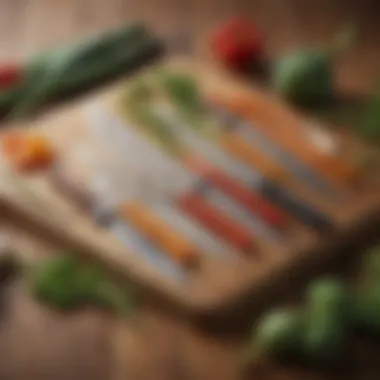
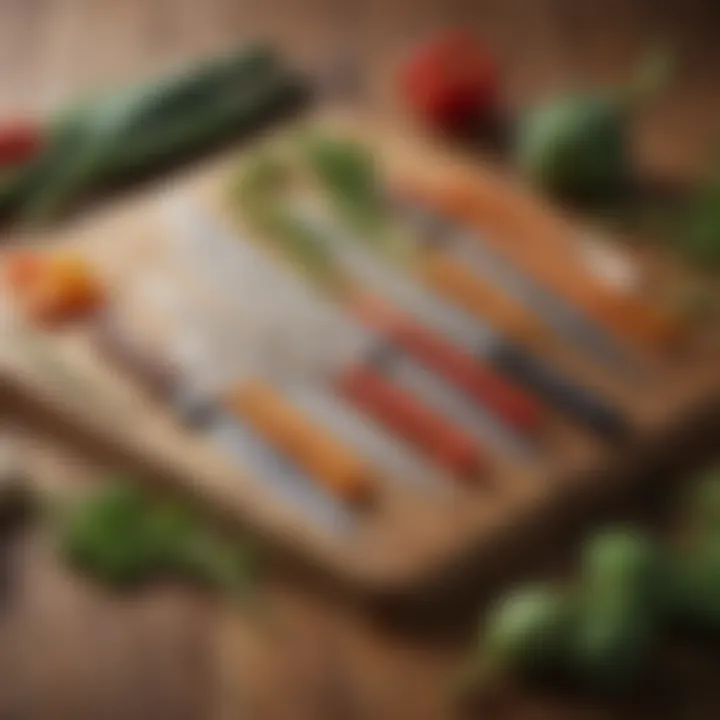
Intro
In the culinary world, the choice of tools can significantly impact the overall cooking experience. Among these tools, vegetable cutting knives play a critical role. Their design, functionality, and importance transcend mere food preparation. They shape the texture and aesthetics of dishes, thus influencing the final taste and presentation.
This guide aims to explore the various aspects of vegetable cutting knives, helping you understand how to select, maintain, and use them effectively. Whether you are a seasoned chef or a home cook, having the right knife can enhance your culinary skills and make food preparation more efficient.
Understanding the Knife Types
A comprehensive discussion on vegetable cutting knives starts with an understanding of the diverse types available. Each type serves a specific purpose and differs in blade shape, length, and material. Here, we categorize several common types:
- Chef’s knife: This versatile knife can handle various tasks, from chopping to slicing. Its broad blade and tapered edge offer control.
- Santoku knife: Featuring a shorter blade, this knife is excellent for precision cutting. Its design often includes a granton edge, which helps prevent sticking.
- Paring knife: Smaller in size, the paring knife is used for delicate work such as peeling and trimming.
- Serrated knife: Ideal for soft vegetables like tomatoes, its serrated edge slices without crushing.
Material Composition
The blade material is crucial for performance and longevity. Common materials used in vegetable cutting knives include:
- Stainless steel: Known for its resistance to corrosion, stainless steel is a popular choice for many cooks.
- High-carbon steel: This material allows for better edge retention and sharpness, but requires more maintenance to prevent rust.
- Ceramic: Lightweight and resistant to corrosion, ceramic knives maintain their sharpness for a longer time.
Understanding these materials helps in selecting a knife that matches your needs.
Knife Maintenance Techniques
Proper maintenance ensures longevity and consistent performance. Here are a few essential techniques:
- Regular sharpening: Use a honing rod or a whetstone to keep the blade sharp.
- Cleaning: Wash knives by hand with warm soap water. Avoid dishwashers to maintain material integrity.
- Storage: Store knives in a designated knife block or on a magnetic strip to prevent dullness and accidents.
Safety Protocols and Ergonomics
Safety during knife handling cannot be overstated. It is important to adopt safe cutting techniques, such as:
- Chopping away from the body.
- Using a cutting board for stability.
- Keeping knives out of reach of children.
Additionally, consider ergonomics. Choosing a knife with a comfortable grip can reduce strain and enhance control during use.
"Investing time in learning proper cutting techniques can elevate your culinary dish to new heights."
Ending
Understanding vegetable cutting knives is essential for anyone passionate about cooking. With the right knowledge, you can select an appropriate knife, maintain its condition, and utilize it safely and efficiently. Such mastery not only enhances your knife skills but also improves your overall culinary experience.
Understanding Vegetable Cutting Knives
Understanding vegetable cutting knives is fundamental for anyone keen on improving cooking skills. These tools are more than just sharp blades; they are instruments that make food preparation more efficient and enjoyable. A well-selected knife can transform the way one approaches cutting vegetables and herbs, helping to achieve consistent results and enhancing overall culinary experience.
Definition and Purpose
Vegetable cutting knives refer to a range of kitchen instruments tailored for the specific task of preparing vegetables. Unlike general knives, vegetable knives are designed with unique blade shapes, lengths, and thicknesses that serve distinct purposes. These characteristics allow culinary enthusiasts to handle various cutting techniques, whether slicing, dicing, or julienne.
The main purpose of a vegetable knife is to offer precision and control while reducing the preparation time. A sharp edge allows for cleaner cuts, preserving the integrity of the vegetable's structure. This leads to better presentation and can even affect the taste of cooked dishes by allowing vegetables to cook evenly.
History of Vegetable Knives
The history of vegetable knives is intertwined with the development of cooking itself. In ancient times, as civilizations began to cultivate and cook food, tools were designed from available materials like flint and metals. These early knives were rudimentary, but they laid the groundwork for specialized cooking tools we have today.
As agriculture advanced, so did the need for better cutting tools. Cultures around the world developed knives tailored to specific tasks, leading to a variety of vegetable knives for different cuisines. For instance, the Japanese santoku knife emerged as a versatile tool for home cooks, while the European chef’s knife evolved to accommodate both meat and vegetables. Today, the variety of vegetable knives reflects not only cultural preferences but also innovations in materials and blade technology that continue to shape culinary practices.
Types of Vegetable Cutting Knives
Understanding the various types of vegetable cutting knives is essential for anyone serious about their culinary skills. Each type of knife serves a specific purpose, allowing for precision and efficiency in food preparation. Selecting the right knife can enhance your cooking experience by improving not just speed but also the quality of your cuts. Different vegetables may require different cutting techniques which can be effectively executed with the appropriate knife. This section will elaborate on several essential types of vegetable cutting knives, highlighting their unique characteristics, benefits, and how to use them effectively in the kitchen.
Chef's Knife
The chef's knife is often considered the most versatile and essential tool in a kitchen. Typically, it features a broad blade that tapers to a sharp point, making it suitable for a variety of cutting tasks, from chopping and slicing to dicing and mincing. A standard blade length for a chef's knife ranges from 8 to 10 inches.
When using a chef's knife, proper technique is important. Hold the knife firmly with your dominant hand while using your other hand to guide the food. Moreover, the weight and balance of the knife allow for efficient cuts. A high-quality chef’s knife is an investment, making it worth considering when establishing your kitchen set.
Paring Knife
The paring knife is smaller than the chef's knife, featuring a blade that generally measures between 3 to 4 inches. This tool is designed for intricate tasks that require more control, such as peeling, trimming, and fine slicing. Its compact size makes it easier to maneuver, which is essential for detailed work.
While not as versatile as the chef's knife, the paring knife is indispensable for close-up tasks. For instance, when peeling fruits or deveining shrimp, this knife excels because of its precision. The grip on a paring knife is also crucial. A comfortable and secure hold allows for more control during intricate tasks, enhancing your overall cutting experience.
Serrated Knife
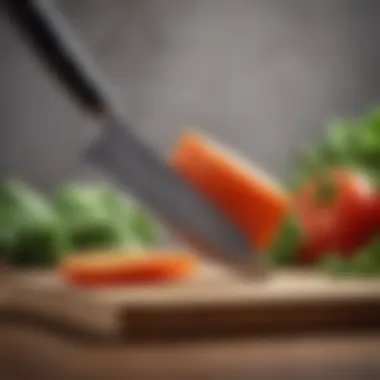
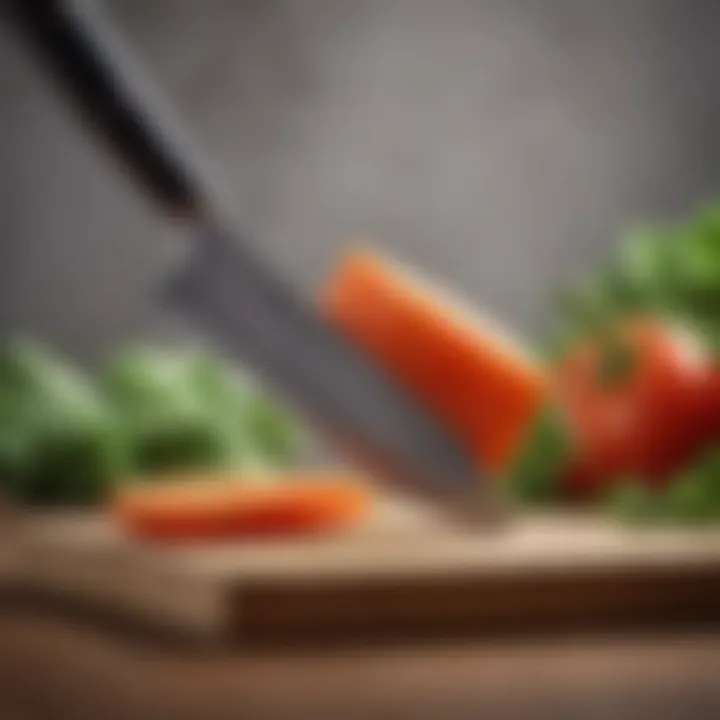
A serrated knife, often recognized by its tooth-like edges, is specially designed for cutting through items with a tough exterior and soft interior. Commonly used for slicing bread, it can also handle fruits and vegetables with skin, such as tomatoes and melons. The serrated edge allows for a sawing motion that cuts cleanly without crushing the food item.
For effective use, make a gentle sawing motion rather than applying too much pressure. This helps in preserving the integrity of the food. A good serrated knife should be comfortable and lightweight, providing ease while slicing through harder surfaces without the need for excessive force.
Cleaver
The cleaver is a robust knife characterized by its broad and heavy blade. Although it is often associated with meat preparation, it is also very effective for chopping vegetables. The weight and design allow for powerful cuts, making it beneficial for breaking down large pieces of produce or even for crushing garlic and ginger.
When using a cleaver, ensure you are using the right cutting board to absorb its weight. Proper technique involves using the heel of the blade for chopping and dicing. The stability it provides can make your chopping tasks easier, allowing for more uniform vegetable cuts.
Santoku Knife
Originating from Japan, the Santoku knife is another versatile tool for the kitchen. This knife is designed with a wider blade, typically around 7 inches, and features a granton edge. The granton edge helps in preventing food items from sticking to the blade, allowing for smooth slicing. The term ‘Santoku’ translates to "three virtues"—slicing, dicing, and mincing—capturing its versatility well.
Using a Santoku knife effectively involves a forward and backward rocking motion, which can make cutting more efficient. This knife is ideal for a variety of vegetables and is quickly becoming a favorite among professional and home cooks alike. Its balanced weight makes it user-friendly, contributing to overall comfort during prolonged use.
In summary, understanding the characteristics and proper uses of these different types of vegetable knives empowers cooks to make informed choices in their kitchen. Having the right tools not only enhances efficiency but also elevates the cooking experience.
Materials Used in Vegetable Knives
When it comes to vegetable cutting knives, the choice of materials is crucial. Each material influences the knife's durability, sharpness, and overall performance. Understanding these materials helps users make informed decisions. This section delves into four primary materials used in vegetable knives: stainless steel, carbon steel, ceramic, and composite materials. Each has its unique properties, advantages, and considerations that every cook should know.
Stainless Steel
Stainless steel is the most common material for vegetable knives. It offers excellent corrosion resistance, making it a practical choice for kitchen environments that involve moisture and food acids. Knives made from stainless steel can maintain sharpness effectively with proper care. However, the hardness may vary among different grades.
- Benefits:
- Durability: Resistant to rust and stains.
- Maintenance: Easier to keep clean than other materials.
- Versatility: Suitable for a variety of cutting tasks.
Despite these benefits, some stainless steel knives may not hold an edge as long as carbon steel knives. This means they may need more frequent sharpening, which is an important consideration for users who value efficiency in the kitchen.
Carbon Steel
Carbon steel knives are favored for their ability to achieve and retain very sharp edges. They are often preferred by professional chefs due to their superior cutting performance. However, these knives do require more maintenance to prevent rust and discoloration.
- Benefits:
- Edge Retention: Stays sharp for a longer period compared to stainless steel.
- Sharpness: Can be sharpened to a finer edge, enhancing precision in cutting.
- Feedback: Offers good tactile response while cutting.
But with the sharpness comes a need for diligence. Regular oiling and careful cleaning are necessary to maintain their appearance and functionality. Users should weigh the benefits against the required upkeep when selecting a carbon steel knife.
Ceramic
Ceramic knives are a newer entry into the knife market. Made from extremely hard materials, these knives retain sharpness longer than many metal counterparts. They are also lightweight and resistant to acids and stains.
- Benefits:
- Sharpness: Stays sharper longer than steel knives.
- Lightweight: Easier to handle in prolonged use.
- Non-reactive: Does not affect the taste of food.
However, ceramic knives can be brittle and prone to chipping or breaking if dropped. They are typically used for slicing soft vegetables and fruits but may not perform well with tougher foods. This fragility should be considered by those who cook with varying materials.
Composite Materials
Composite materials combine various elements to create durable and versatile knives. These often include layers of steel or other metals bonded with plastic or wood elements.
- Benefits:
- Strength: Combines the benefits of different materials, enhancing performance.
- Design: Unique aesthetics from varied materials and colors.
- Flexibility: Can serve multiple cutting tasks effectively.
While composite knives aim to provide the best of both worlds, they can also be a little more expensive due to their complex manufacturing process. Users must consider their budget when looking at options made from composite materials.
In summary, the material chosen for a vegetable knife can significantly impact its performance. Understanding the pros and cons of each material guides users in making a choice that suits their needs and cooking style.
Key Features of High-Quality Vegetable Knives
When selecting a vegetable cutting knife, understanding its key features can significantly enhance the cooking experience. A high-quality vegetable knife should exhibit specific attributes that contribute to its functionality, comfort, and longevity. These qualities directly influence how effectively the knife performs its tasks and how enjoyable it is to use them in the kitchen.
Blade Sharpness and Edge Retention
Blade sharpness is perhaps the most critical factor in a vegetable knife. A sharp blade can slice through vegetables cleanly and with minimal effort. This not only increases efficiency but also preserves the structural integrity of the produce, allowing for cleaner cuts and less bruising.
Edge retention is another vital characteristic. It describes how well a blade maintains its sharp edge over time. High-carbon stainless steel blades, for example, tend to hold their sharpness longer compared to lesser-quality steel. To maintain blade sharpness, regular honing and occasional sharpening are essential. The precise angle of the edge also plays a role in retention; a well-crafted angle reduces wear and keeps the knife functional for extended periods.
Weight and Balance
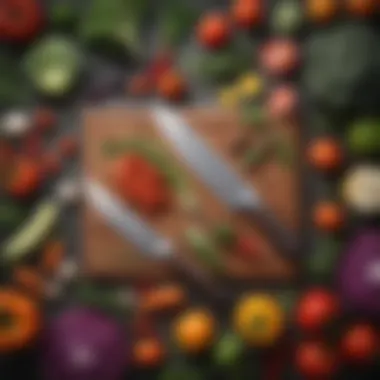

Weight and balance are key components that affect the usability of a vegetable knife. A well-balanced knife ensures that the weight is distributed evenly. This allows for natural movement and reduces strain during use. A heavy knife may feel sturdy and robust, while a lighter knife grants increased agility.
Choosing the right weight often depends on personal preference and the type of vegetables being cut. For instance, chopping dense vegetables like carrots may benefit from a heavier knife, while delicate herbs might be better handled with a lighter option. Attention to the balance and feel of the knife can enhance comfort and efficiency in food prep tasks.
Handle Design and Comfort
The design and comfort of the handle are also integral to a quality vegetable knife. A comfortable handle promotes better grip and control during cutting tasks. Handles made from materials such as wood or high-quality synthetic composites can provide excellent grip and reduce the chances of slipping, even when wet.
The shape of the handle is equally important. Ergonomically designed handles fit the contours of the hand, allowing for a more natural grip. This reduces hand fatigue during prolonged use, making it easier to enjoy cooking without discomfort. Different hand sizes and gripping styles should be factored into the selection process as well.
"The perfect knife marries functionality with comfort, enhancing the overall kitchen experience, and empowering culinary creativity.''
Importance of Maintenance and Care
Maintaining and caring for vegetable cutting knives is crucial to ensure their longevity and effectiveness. A well-cared knife not only performs better but also enhances safety and efficiency in the kitchen. Understanding how to properly maintain tools allows cooks to achieve better results and develop their culinary skills more effectively.
Sharpening Techniques
Regular sharpening of vegetable knives is essential. A dull knife requires more pressure, which can lead to accidents and uneven cuts. The two main methods of sharpening include using a whetstone and professional sharpening services. For a whetstone, the process involves:
- Preparation: Soak the whetstone in water for about ten minutes. This helps to create a slurry which aids in sharpening.
- Angle: Maintain the correct angle, typically around 20 degrees for most vegetable knives.
- Stroke Technique: Draw the blade across the stone, applying light, even pressure. Each side of the blade should receive equal attention.
- Finishing: Use a finer grit for honing the edge. This final step refines the blade for a sharper finish.
Using a honing steel regularly can help maintain the edge between sharpening sessions.
Cleaning Procedures
Proper cleaning is vital to prevent corrosion and maintain hygiene. After each use, knives should be cleaned with warm, soapy water and a soft sponge. Avoid putting them in a dishwasher, as the high heat and harsh detergents can damage the blade and handle. Here are important considerations for cleaning:
- Immediate Action: Clean the knife immediately after use to prevent residue from hardening.
- Drying: Always dry the knife thoroughly, ensuring that moisture does not linger.
- Avoiding Abrasives: Use gentle sponges or cloths; abrasives can scratch and dull the blade.
Storage Options
Storing knives correctly is equally important for maintaining their condition. Using a knife block, magnetic strip, or protective sheaths can prevent blades from becoming dull or damaged. Consider the following:
- Knife Blocks: Ideal for keeping knives organized and protected.
- Magnetic Strips: These free up countertop space and make knives easily accessible without causing damage.
- Protective Sheaths: They provide a safe option, especially for those who store knives in drawers.
Ensuring proper maintenance of vegetable knives greatly extends their life and maintains performance, a benefit not only for cooks but also for the culinary enjoyment of meals prepared.
In summary, investing time in sharpening, cleaning, and storing vegetable cutting knives properly creates a safer, more efficient cooking experience. These practices will keep knives in prime condition and enhance overall culinary skills.
Safety Protocols in Knife Handling
Safety protocols in knife handling are crucial in any culinary environment. These protocols help prevent accidents, ensuring that cooking remains an enjoyable task rather than a hazardous one. Proper safety measures not only safeguard users but also enhance overall efficiency in the kitchen. When using vegetable cutting knives, understanding and implementing safety protocols is of utmost importance. This section delves into two critical aspects of safety: proper grip techniques and cutting surface considerations.
Proper Grip Techniques
Using the right grip is essential for safe knife handling. A secure and appropriate grip can significantly reduce the risk of slips and accidents.
- Pinch Grip: This is the most recommended grip for precision. Place your thumb and index finger on the blade, gripping it just above the handle, while the remaining fingers grasp the handle firmly. This method provides excellent control.
- Handle Grip: Though less recommended for precise movements, this grip involves holding the knife handle with all fingers wrapped around. This grip is suitable for coarse cutting tasks where precision is not critical.
- Hold Your Knife Securely: Regardless of the grip, ensure that your hold is firm. A loose grip can lead to unwanted movements, causing the knife to slip.
Understand that a stable grip translates directly into better control while using your knife. Familiarizing oneself with different grip techniques is vital, especially for individuals who do not regularly handle knives. Practicing the pinch grip can enhance one's confidence and reduce accidents in the kitchen.
Cutting Surface Considerations
The surface on which you cut vegetables is equally important for safety. A stable cutting surface allows for better knife control, minimizing the risk of injury. Consider the following factors:
- Non-slip Mats: Utilize a cutting board with non-slip features or place a damp cloth underneath your board. A firm, steady base prevents the board from moving while you cut.
- Material Selection: Opt for cutting boards made from wood, bamboo, or plastic. Glass or stone boards can dull knives quickly and are more hazardous as they can cause slips.
- Clean Space: Ensure your cutting surface is clean and free from any obstacles. A cluttered counter can lead to distractions, increasing the chances of accidents.
Inculcating proper grip techniques and utilizing appropriate cutting surfaces goes a long way in maintaining a safe culinary environment.
Practicing these protocols will not only make cooking more enjoyable but also help in developing a strong foundation for knife skills. Safety should never be underestimated, as it is essential for a smooth and productive kitchen experience.
Ergonomics and User Comfort
The significance of ergonomics in the context of vegetable knives cannot be understated. Ergonomic design influences the function and experience of using the knife. Comfort during cutting tasks enhances efficiency and reduces the risk of injuries. Therefore, understanding how to select a knife that fits well in your hand is essential for anyone who cooks regularly.
Selecting the Right Size
Choosing the right size of knife is fundamental in attaining a comfortable cutting experience. A knife that is too large may become unwieldy, while a knife that is too small may not provide the necessary leverage for tougher vegetables. The length and weight of a knife should correlate with the user’s hand size and strength.
- Small hands may benefit from a shorter blade, around six to eight inches, which offers better control.
- Larger hands might require longer blades, generally within the eight to ten inches range, to provide adequate cutting power.
Typically, chef's knives fall within this range and become a versatile option for most cooks. Ultimately, it is advisable to hold and test various knives before making a purchase to find the right fit.
Reducing Hand Fatigue
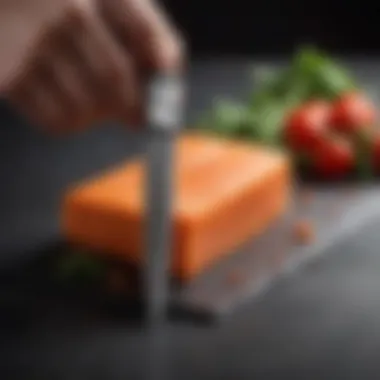
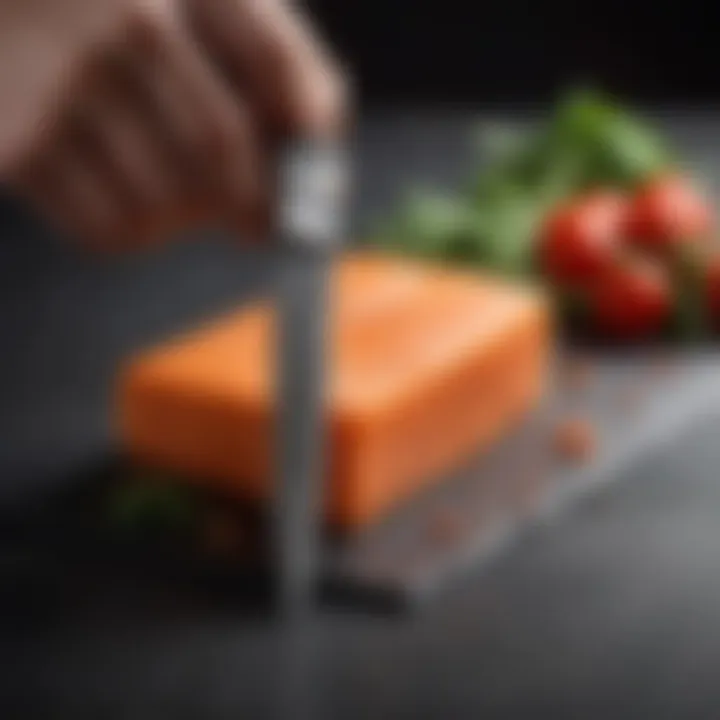
Reducing hand fatigue is another critical aspect of ergonomics that greatly influences the cooking experience. Hand fatigue can occur during prolonged use of a knife, leading to discomfort and even pain. Choosing a knife designed for comfort can mitigate this issue. Features to look for include:
- Weight Distribution: A well-balanced knife should not feel heavy at the tip. This balance helps distribute pressure evenly.
- Handle Design: Knives with contoured handles made from materials such as thermoplastic or rubber can provide additional grip and comfort.
- Grip Texture: A textured handle can prevent slipping, which can cause discomfort during extended periods of use.
Adopting proper cutting techniques can also reduce fatigue. For instance, using a steady rhythm and employing body weight to assist rather than relying solely on hand strength can enhance endurance in the kitchen.
"The right knife is as essential as the cooking skills to master its use. Comfort in your tools can elevate your culinary experience."
Cutting Techniques for Vegetables
Proper cutting techniques are essential for anyone who cooks, from novice home chefs to experienced culinary professionals. Understanding how to properly slice, chop, and dice vegetables not only enhances the presentation of a dish but also affects cooking time and the final flavor. Accurate cutting ensures even cooking and improves the overall quality of the meal. Learning various cutting techniques can also reduce the risk of injury, which is just as important in a kitchen setting.
Basic Cutting Techniques
Basic cutting techniques form the foundation of vegetable preparation. Mastering these skills provides efficiency and versatility in the kitchen. Here are some fundamental methods:
- Slicing: This involves cutting vegetables into thin, flat pieces. For example, when slicing onions or tomatoes, a consistent thickness is crucial for even cooking.
- Dicing: Dicing creates small, uniform cubes. Start by slicing the vegetable lengthwise, then crosswise to achieve the desired cube size. This technique is commonly used for carrots and peppers.
- Chopping: Chopping is less precise than dicing but helps to quickly prepare vegetables. It typically results in larger pieces than dicing and is useful for stir-fries or soups where ingredient sizes can vary.
- Julienne: This method involves cutting vegetables into thin matchstick-like pieces. It is particularly useful for vegetables like zucchini and bell peppers to add texture to salads or stir-fries.
- Brunoise: A more precise version of dicing, brunoise cuts vegetables into very small cubes. This technique is time-consuming but adds elegance to dishes like soups and sauces.
These basic techniques can be practiced with a variety of vegetables, helping to build familiarity and skill over time. Proper grip and knife control are also necessary to avoid accidents and ensure fluidity in the cutting process.
Advanced Techniques
Once the basics have been mastered, certain advanced techniques can further elevate one’s vegetable cutting skills. These methods require practice but can greatly enhance meal preparation:
- Chiffonade: This technique is primarily used for leafy greens and herbs. Leaves are stacked, rolled tightly, and then sliced to create fine ribbons. This is great for garnishing or adding flavor to dishes like pastas or salads.
- Mise en place: Although not a cutting technique per se, this French term refers to the practice of preparing and organizing ingredients before cooking. This involves cutting all vegetables into the necessary shapes and sizes beforehand, allowing for a smooth cooking process.
- Tourné: This is an intricate technique that involves cutting vegetables into a specific, oval shape with seven sides. Often used for presentation in high-end cuisine, it takes time to master and requires precision.
- Supreme: For citrus fruits, this method entails segmenting the flesh while removing the pith. This technique is especially useful in salads or when garnishing dishes with fresh fruit.
Mastering these advanced techniques can make cooking not only more efficient but also more enjoyable. They allow for creativity and personalization in meal preparation.
By developing both basic and advanced cutting techniques, the cook can enjoy a greater level of control in the kitchen, creating dishes that not only taste good but also look appealing. Each cut made with precision contributes to the art of cooking and ultimately enhances the dining experience.
Choosing the Right Vegetable Knife
Selecting the right vegetable knife is crucial for any cooking endeavor. This choice not only influences the efficiency of your prep work but also impacts the overall culinary experience. Each knife has its unique function and characteristics, which can greatly enhance your ability to handle vegetables effectively. Furthermore, the right knife can aid in the development of skills and techniques in the kitchen, making cooking a more enjoyable activity.
Assessing Personal Needs
Personal needs play a significant role in determining which vegetable knife is best suited for you. Every cook has different preferences, styles, and requirements based on the types of vegetables they typically prepare and the techniques they favor. Here are some considerations:
- Frequency of Use: If you cook daily, investing in a high-quality knife that feels comfortable and performs well is essential. For occasional cooks, a versatile, budget-friendly option may suffice.
- Types of Vegetables: Consider the vegetables most commonly used. A chef's knife may be ideal for slicing and dicing larger vegetables, while a paring knife might be perfect for more intricate tasks.
- Cooking Styles: If you lean toward oriental cooking, a Santoku knife could provide the multi-functionality you desire. Assessing your predominant cooking style should guide your selection.
- Physical Comfort: Assessing hand size, grip preferences, and weight tolerance are key. A heavy knife may feel sturdy but could lead to fatigue when used for extended periods. A lightweight knife, while easy to handle, might not feel as solid.
Evaluating Knife Options
When exploring different knife options, it is essential to take into account several decisive factors. This assessment can significantly influence the quality of your knife selection:
- Material Quality: Knives constructed from high-carbon stainless steel typically boast superior edge retention. Alternatively, ceramic knives are lighter, though they can be more prone to chipping.
- Design Features: Consider the handle shape and material, as well as the blade's design. A well-balanced knife will facilitate smoother cuts and reduce strain on the wrist.
- Brand Reputation: Certain brands maintain a reputation for quality. Brands like Wüsthof, Shun, and Victorinox have established themselves with many chefs worldwide. Research user reviews and ratings to pinpoint strong options.
- Budget Constraints: Quality knives can be an investment, but there are options available across a range of price levels. Establishing a budget before purchasing can help navigate the market effectively.
Brands and Recommendations
Selecting the right vegetable cutting knife involves not just understanding the different types and materials but also knowing which brands are worth considering. The brand can significantly influence the quality, performance, and longevity of a knife. Reputable brands often invest in research and development, ensuring their products meet the necessary standards for durability and functionality.
Top Knife Brands
When looking for vegetable cutting knives, some brands stand out due to their commitment to quality, craftsmanship, and user satisfaction. Here are a few esteemed names:
- Wüsthof: This German brand is known for its precision-forged knives, offering excellent sharpness and durability. Wüsthof has a range of vegetable knives that cater to both professionals and home cooks.
- Victorinox: Another Swiss brand, famous for its affordable yet high-quality products. Their knives are lightweight and designed for comfort, making them ideal for prolonged use in the kitchen.
- Shun: This Japanese brand specializes in handcrafted knives, ensuring exceptional sharpness and aesthetics. Shun knives are typically made with high-quality steel, making them suitable for precise cutting tasks.
- Global: Known for their modern design and lightweight construction, Global knives are popular among chefs looking for performance and style. Their vegetable knives often have a unique blade shape for enhanced cutting efficiency.
Choosing a knife from a reputable brand ensures you get a reliable product that is likely to perform well over time.
User Reviews and Feedback
User reviews and feedback are crucial in the decision-making process. They provide insights into real-life experiences with knives that specifications alone might not reveal. Considering feedback from other culinary enthusiasts can help you understand the strengths and weaknesses of specific models. Here are some considerations:
- Quality Observations: Users often share their thoughts on how well a knife holds its edge, its balance, and weight distribution during use.
- Practical Experiences: Look for reviews that detail how the knife performs when cutting different types of vegetables. Some users might mention how a knife is particularly effective for chopping herbs but not as agile for slicing tomatoes.
- Durability Reports: Users frequently comment on how long their knives last under regular use and whether they show signs of wear and tear after a period of time.
Feedback gathered from trusted platforms such as Reddit or cooking blogs can be invaluable. Moreover, it's wise to balance the expert opinions with customer reviews to get a comprehensive view of any knife's performance.
"Choosing a knife isn't just about picking a brand, but matching the tool to your culinary style and preferences."
In summary, when considering brands and recommendations for vegetable cutting knives, focus on those with established reputations. User reviews can provide significant insights that enhance your understanding of the options available. This knowledge aids not only in making an informed choice but also in investing in a knife that aligns with personal cooking habits.
The End
The conclusion serves as a vital part of this article about vegetable cutting knives. It synthesizes the information presented in the earlier sections, reinforcing the essential takeaways for the reader. Understanding the key points about types, materials, maintenance, safety, and ergonomics helps in making informed decisions when selecting the right vegetable knife. This knowledge not only enhances kitchen efficiency but also increases safety while preparing food. Ignoring these aspects can lead to inefficient cooking and unnecessary injuries.
Summarizing Key Points
- Types of knives: Different knives serve varied purposes, such as the chef's knife for general use, the paring knife for detail work, and the cleaver for heavy chopping.
- Materials matter: The material used in blades affects sharpness, durability, and maintenance. Stainless steel, carbon steel, ceramic, and composites all come with unique benefits.
- Maintenance is crucial: Regular sharpening, proper cleaning, and suitable storage extend the knife's lifespan and ensure optimal performance.
- Safety protocols: Following safety practices, like proper grip techniques and cutting surface choices, minimizes risks of accidents during cooking.
- Ergonomics: Selecting knives that reduce hand fatigue enhances comfort and productivity in the kitchen.
Final Thoughts on Selection and Use
Selecting the right vegetable knife is an amalgamation of personal preference and practical requirements. When choosing, consider your cooking style, the types of vegetables you work with, and how often you use the knife. Testing different grips and weights can be beneficial in ensuring comfort and functionality. Additionally, investing time in understanding maintenance techniques will pay dividends in performance and longevity. Ultimately, the proper knife not only elevates culinary efficiency but also makes the entire cooking experience more enjoyable.







